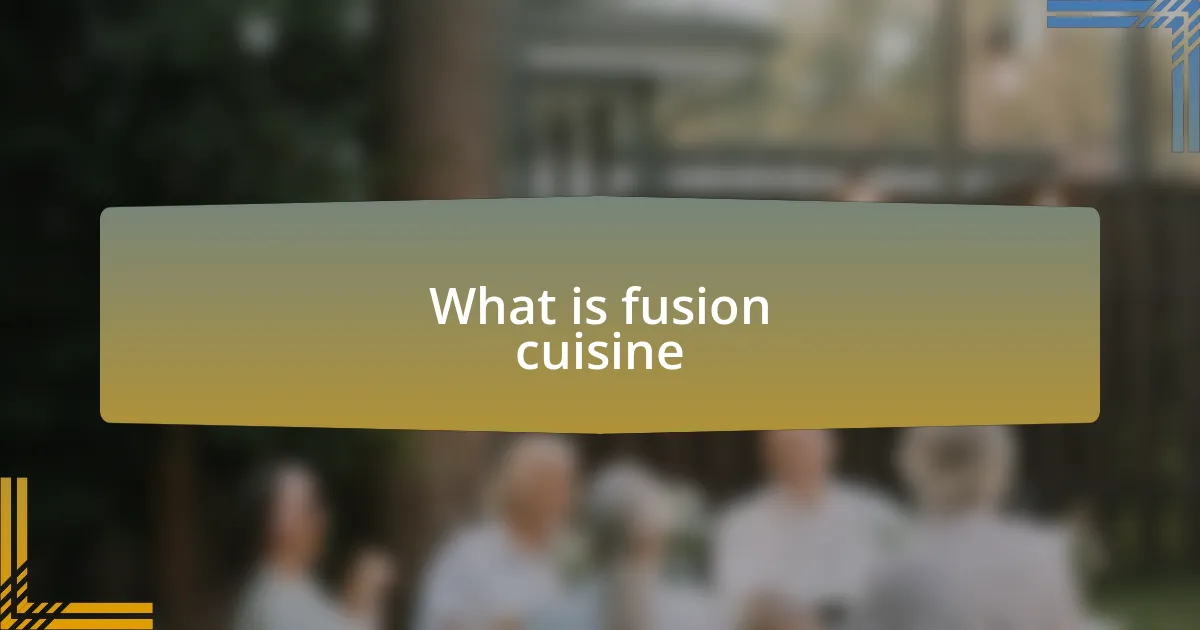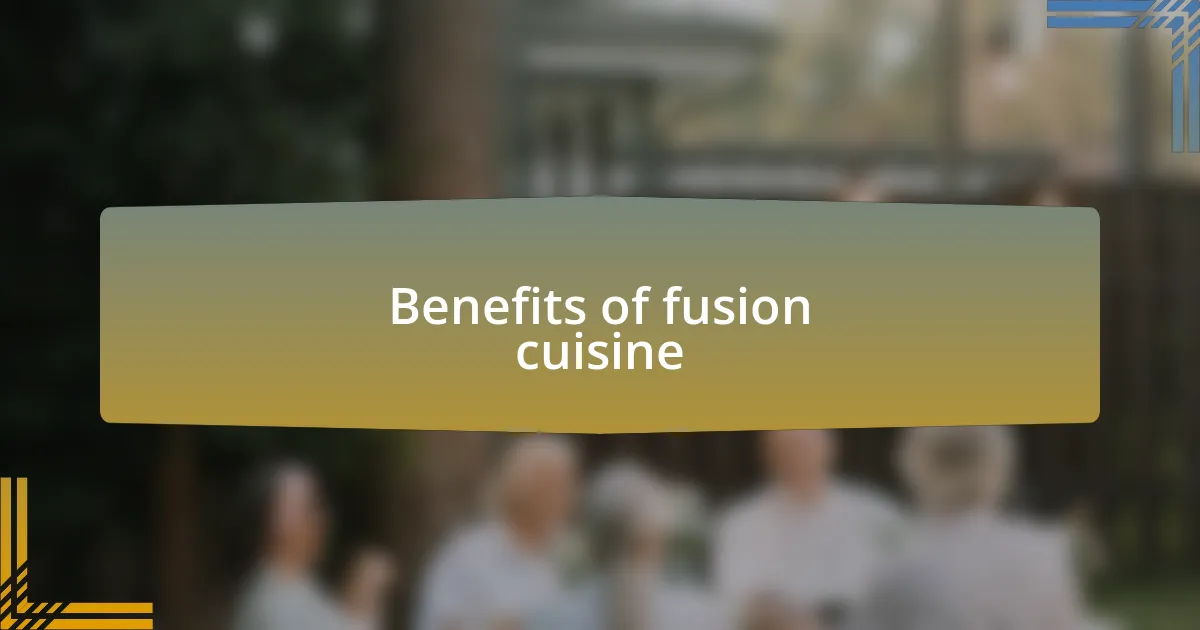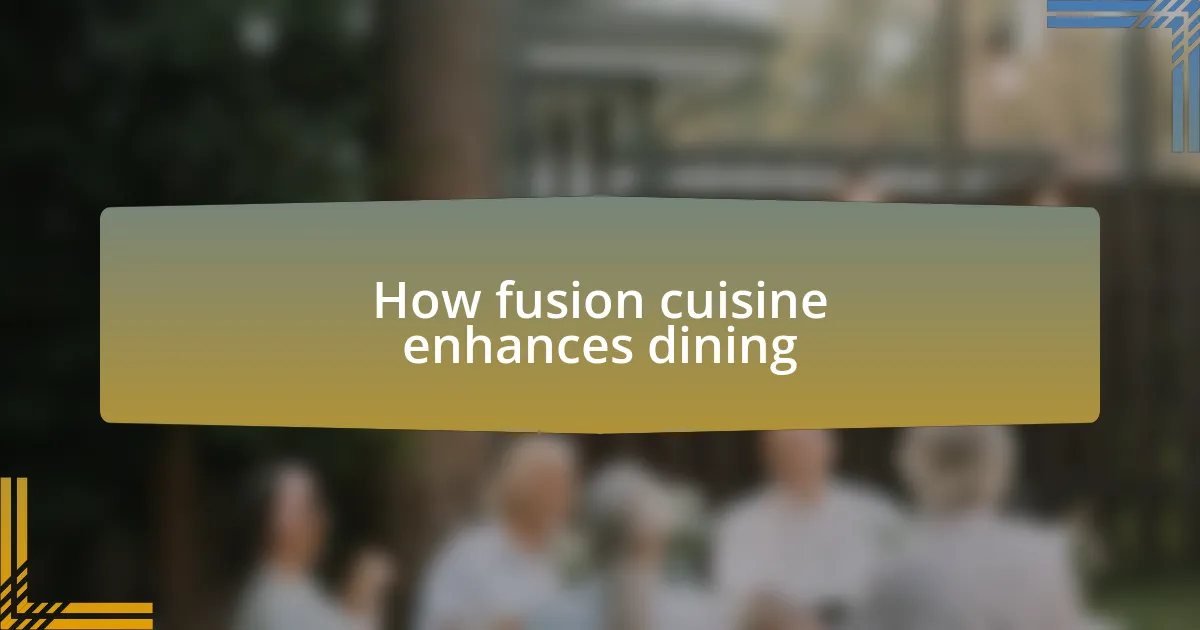Key takeaways:
- Fusion cuisine creatively blends culinary traditions, resulting in innovative dishes and unexpected flavor pairings that celebrate diverse cultures.
- It enhances dining experiences by fostering community connections, as seen in activities like cooking classes and theme nights in retirement homes.
- Fusion cuisine allows for dietary inclusivity, accommodating various preferences while still delivering delicious meals that tell stories of heritage.
- The culinary exploration in fusion cuisine emphasizes the importance of sharing and creating connections, turning meals into celebrations of identity and creativity.

What is fusion cuisine
Fusion cuisine is an exciting culinary approach that blends different culinary traditions to create innovative dishes. I remember the first time I tasted a sushi burrito; the combination of fresh seafood and traditional Mexican flavors took me by surprise. How could two seemingly disparate cultures come together so beautifully on one plate?
At its core, fusion cuisine is about creativity and exploration. It invites chefs to experiment with ingredients and techniques from various cultures, often resulting in unexpected flavor pairings. For instance, I once tried a Thai-inspired pizza topped with spicy peanut sauce and fresh cilantro, which made me question what else can be combined in delightful ways. Isn’t it fascinating to think about the possibilities that arise when culinary boundaries are blurred?
Emotional connections also play a role in fusion cuisine. When I prepare a dish that combines my grandmother’s Italian recipes with a dash of Korean spice, it becomes more than just food; it’s a tribute to my heritage. Does your favorite dish tell a story that transcends borders? Fusion cuisine allows us to share those stories while celebrating our diverse culinary landscapes.

Benefits of fusion cuisine
Exploring the benefits of fusion cuisine reveals how it enhances our culinary experiences. I recall an unforgettable dinner where a fusion dish—Indian curry tacos—opened my eyes to new flavor combinations. The spices from the curry melded beautifully with the crispness of the taco shell, showcasing that diverse culinary cultures can elevate our meals in surprising ways. Isn’t it wonderful when food surprises us with its creativity?
Another significant advantage of fusion cuisine is its ability to cater to a variety of dietary preferences. For instance, I once enjoyed a vegan Italian-Japanese dish, featuring a plant-based risotto infused with miso. This experience taught me how fusion can accommodate different lifestyles while still being delicious, a win-win for everyone at the table. How can we resist such inclusive dining experiences?
Lastly, fusion cuisine fosters cultural appreciation and understanding. I remember being at a potluck where each dish represented the heritage of a resident, from Moroccan tagines to Italian risottos. As I savored each bite, I felt a deeper connection to these diverse cultures. Isn’t it lovely to think that food can serve as a bridge, uniting people through shared culinary adventures?

Exploring luxury retirement homes
Luxury retirement homes offer an immersive living experience that goes beyond just comfort. I remember visiting one that featured not only beautifully designed interiors but also elegant outdoor spaces where residents could socialize or enjoy quiet moments of reflection. The ambiance was inviting and exuded a sense of peace that made me feel right at home. Who wouldn’t appreciate such a blend of luxury and serenity in their later years?
As I explored various facilities, I noticed that many luxury retirement homes facilitate a vibrant community life. Engaging activities, from art classes to cultural outings, create a dynamic setting that inspires residents to connect with one another. I’ve seen joy on the faces of residents as they shared laughter during a cooking class or reminisced about their travels on a group excursion. Doesn’t it warm your heart to see friendships bloom in such rich environments?
The culinary offerings in these homes also deserve a spotlight. A memorable experience involved dining in a home where chefs crafted meals using locally sourced ingredients. As I tasted a perfectly seared salmon paired with seasonal vegetables, I realized that dining is not just about nourishment; it’s an experience that brings residents together. How amazing is it when every meal becomes a celebration of both flavor and community?

Culinary experiences in retirement homes
When I visited another luxury retirement home, I was struck by the theme nights they organized, where residents could savor international cuisines from around the globe. Picture this: a vibrant Italian night filled with the aroma of freshly baked pizzas and homemade pasta, where residents gathered to share not only the meals but also stories from their own travels. It was a delightful reminder that food transcends cultures and unites us in such special ways. Can you imagine how that sparks excitement and creates lasting memories among friends?
One afternoon, I joined residents in a delightful cooking class that featured fusion cuisine, a blend of culinary traditions from different parts of the world. As we carefully combined flavors, such as Thai spices with classic French techniques, I felt the camaraderie in the kitchen. The laughter and shared learning created a sense of belonging. Isn’t it inspiring how cooking together can bridge generations and create an inviting atmosphere?
Moreover, the dining experience itself often feels like fine dining, where every plate is crafted with care. During one meal, I was fortunate to be part of a communal dining experience where everyone sat together, sharing not only food but also laughter and conversation. Each bite of the artisanal bread, fresh salad, and delectable dessert was enhanced by the warm connections being made. It truly emphasized that in these homes, culinary experiences are as much about companionship as they are about the food. How powerful is that sense of community at the dinner table?

How fusion cuisine enhances dining
When I first experienced fusion cuisine in a retirement home setting, I was amazed at the delightful surprises that came with each dish. One evening, we enjoyed a sushi roll infused with Mediterranean flavors—think tangy olives and rich pesto paired with fresh fish. It was a culinary journey that sparked conversations about food preferences and recipes from our pasts. How exciting is it to explore how cultures can blend so seamlessly on our plates?
I vividly recall a specific dining event that showcased an Indian-Mexican fusion dish. The spicy aroma of curry mixed with the comforting essence of enchiladas was unforgettable. Residents eagerly shared stories about their own culinary backgrounds and how these flavors reminded them of family gatherings. Isn’t it wonderful how a meal can evoke such nostalgia and connection, transforming dining into an interactive experience filled with shared memories?
Moreover, fusion cuisine invites creativity into the dining experience, allowing chefs to push boundaries while catering to diverse palates. I once observed how residents lit up when given the chance to add their unique twists to dishes, mixing unexpected ingredients like coconut milk with chocolate to create a delectable dessert. This not only enhanced the flavors but also encouraged a sense of ownership and pride in the dining process. How often do we get to experience food as a canvas for our personal expressions?

Personal journey of culinary discovery
As I embarked on my culinary journey, I found myself captivated by the unexpected marriages of flavors that fusion cuisine offered. One memorable occasion was a simple cooking class within the retirement home, where we transformed traditional Italian risotto by infusing it with Thai spices. The excitement in the room was palpable; we were not just cooking but creating an experience that tasted like a shared adventure.
Another time, I vividly recall a potluck-style event where each resident was encouraged to showcase their cultural heritage through food. One resident, originally from Japan, introduced us to a dish where he blended elements of soul food with miso, creating a gumbo that felt like a warm embrace. Sitting around the table, I marveled at how food had the power to unite us, bridging generational gaps and igniting laughter, stories, and even a few friendly debates about ingredient combinations.
In these moments, I realized that culinary discovery was less about the food itself and more about the connections formed around it. I often reflect on how fusion cuisine encourages us not just to taste but to share our stories and passions. What could be more exciting than exploring the diverse cultures represented right in our dining room, turning meals into a celebration of identity and creativity?